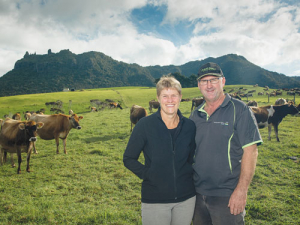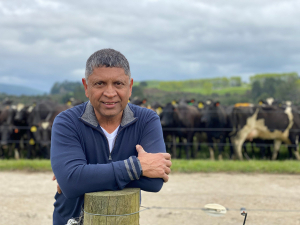Jagger runs a Jersey-cross beef business as a lucrative sideline to his Jersey dairy farm.
He is a sixth-generation Whangarei Heads farmer on a 550ha property milking about 650 Jersey cows on 230ha and he runs a dairy beef operation carrying about 220 Jersey/Angus cross cattle on the marginal land.
“Over the last 10 years the dairy industry has grown about 50%,” Jagger told the Jersey NZ conference in Whangarei.
“The beef industry has declined 31% and the sheep industry has declined 40%.” Prime beef land has been lost to dairy.
Of the current beef kill, 70% is sourced from the dairy industry. Of that, 28% comes from the dairy beef side not including bobby calves. “Alongside that we have the current push for a reduction in our bobby calf kill.
“So there is room for improvement and there are opportunities for us all.”
Global trends in flavours and tastes are influencing cuts, and Angus and Wagyu are becoming more of a trend, he says. Customers are more focused on where their food comes from, animal welfare and the packaging.
What does that mean for the Jersey breed? he asked.
“If you hadn’t realised it, fat is back…. But it is not just about milk, this about the fat that affects flavour in meat. We are well placed as a breed,” he says.
“A project at Massey in about 2006 was a study of Jersey meat quality. An outstanding characteristic of Jersey cattle is the high level of intra-muscular fat, and under pasture feeding conditions the genetic potential of breed to deposit that fat into the carcase is important.
“And beef from Jersey cattle is very high in tenderness. Taste panels have consistently rated Jersey cattle beef as being more acceptable due to its greater tenderness, juiciness, flavour and overall acceptability.
“Jersey cross cattle have mono-saturated fat concentrations that are significantly higher than other breeds, [hence] the interest in these… there is a belief that they have gone from cholesterol-neutral to cholesterol-lowering. So there are many elements of the breed itself that translate into a meat carcase.”
In 2009 AgResearch asked Jaggers to supply Jersey Angus cross heifers for a trial by Anzco Foods on behalf of Five Star.
He had already sold his 18-month heifers so he trucked his second tier of animals to Invermay where they were put to trial alongside straight Hereford heifers to look at marbling content. They grew at the same rate as the Angus Hereford cross and the marbling scores of the Angus Jerseys were more consistent.
The animals grew at 0.79kg/day. A number of research projects in the last few years indicate that by using easy-calve beef bulls over a Jersey or a cross-bred you can achieve a growth rate of about 0.65kg/day. But if you use higher-genetic EBV bulls you can achieve another 0.4kg/day which was consistent with the animals in the AgResearch trial.
“The comment was made that these animals grew in comparison to the straight beef line because of the higher EBV focus in the bull selection. So it is important to focus on better gull genetics in your beef.”
Jersey farmers need to change the perception of Jersey as unsuitable for beef production, he says. Despite rearing cross-bred Jerseys for 30 years and having access to his father’s Angus herd, Jagger says it has been a battle gaining acceptability of Jerseys as worth putting beef over.
“We need to change the perception of fat, colour and lack of growth, by using quality EBV bulls. We can change the fat colour and reduce the bright yellow colour you get with a straight Jersey animal by using better genetic beef bulls.
“People have a perception of yellow fat and they don’t want it; but overriding that is flavour.” Using better bulls causes the colour to diminish “somewhat,” he said.
“We also need to change the perception that Jersey-cross calves are hard to rear. It is probably something you have all heard before -- that they are hard to rear. That is rubbish.”
“We need to go forth and re-educate, advocate and repopulate. One of the things is telling the story and it is not just a dairy genetics story,” he says.
“We have a real opportunity in the way the markets are developing and the focus on flavour to leverage the breed we have.”
Choosing better bulls
Jersey dairy farmers have an opportunity in beef breeding by choosing better quality bulls, says Jagger.
“We need to treat Jersey-cross calves as part of our herd improvement plan.
“The number of dairy farmers who ask a stock agent to go and source x number of bulls to tail-off with and don’t focus on the quality of the bulls is larger than the number of farmers who ask for figures on those beef bulls.”
Jagger says Jersey dairy farmer’s herd improvement plan can identify cows not wanted for milking herd replacement calves and use better quality bulls over them with a beef focus.
“When you buy a bull just from the yards or get a stock agent to source them you don’t know what the calving ease is, you don’t know what the birth weight is and you don’t know what the 600-day growth weights are.
“By focussing on those things we can deliver a really good product into the marketplace and protect our herd in terms of calving ease.
“Because that is what we are about: getting cows in calf and having cows calve easily; and we are fortunate to have a breed that does that and we don’t want any issues, we just want cows in milk. But we can have both if we focus on the right areas.”
Jagger says developing a market for calves also reduces the bobby calf issue.
















